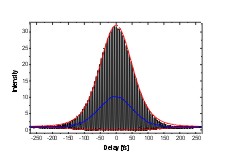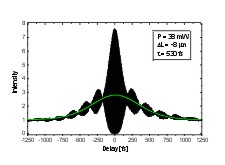|
|
|
|
|
© Stefan Marzenell |
|
Multiphoton interferometric autocorrelation (AC) techniques |
|||
|
We use photodiodes to measure intensity and interferometric autocorrelations at different wavelengths. The advantages of direct Two- (2PA) and Three- (3PA) Photon absorption in photodiodes are:
|
|
We have used different photodiodes for each wavelength range. These are shown in the table below. The source and its possible wavelength can also be seen in the experimental setup of the OPO system. |
|
|
We have made a comparison between 2PA (Si) and 3PA (GaAsP) measurements at a wavelength of 1.58 µm. We have measured the same pulse duration for each autocorrelation. A 3PA measurement with a sech2-shaped pulse of duration 95 fs is shown below. The upper and lower envelope in red and the intensity autocorrelation in blue are calculated with the cited pulse duration. |
 |
||||||||
|
To characterize to AgGaSe2-OPO it was necessary to measure all three involved pulses (pump, signal, and idler) at the same time. It was of special interest to determine pulse duration and pulse chirp as a function of resonator length as this influences the power and therefore the self phase modulation as well as dispersion because the wavelength changes to stay resonant with the fixed pump repetition rate. Examples for signal and idler wave, respectively, are shown below. |
||||||||
 |
||||||||
 |
||||||||
|
The measurement of the idler wave was performed with a peltier cooled InAs photodiode. |
||||||||
|
[Home] [Research] [Presentations] [Publications] [Links] [etc.] [Contact] |
||||||||